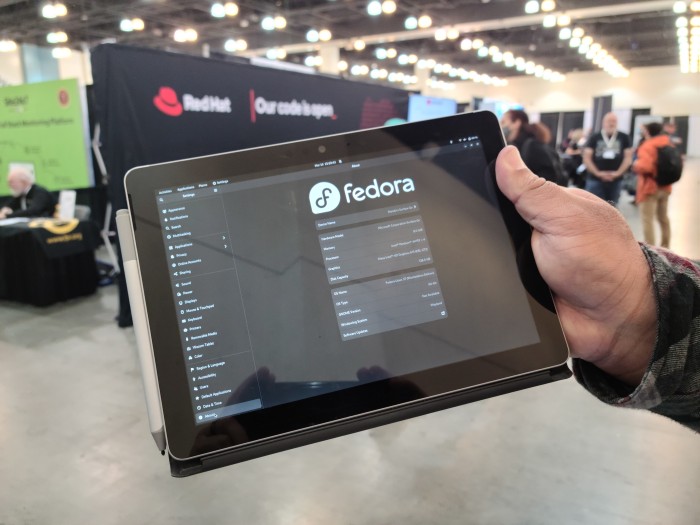Originally published at: Fedora at SoCal Linux Expo 20x – Fedora Community Blog
The Southern California Linux Expo (SCaLE) returned to Pasadena, CA and Fedora came back as an exhibitor. It was a very successful year for Fedora: attendees voted us “Most Memorable Booth”!
Fedora at SCaLE
I have now attended SCaLE every year since 2010, shortly after I moved to California. Since the last SCaLE was in late July, there was less time between them. As a result, I noticed a few things that contributed to this year’s SCaLE being an particularly special year: many larger corporate vendors who were at SCaLE last year didn’t come back this year, so it felt like there were more hobbyist and community groups to fill in the space. At the same time, many who had not been travelling due to COVID returned for the first time in years. It resulted in SCaLE feeling a bit more genuine this year with a crowd of people who largely knew what Linux and open source are about and were excited to be there.
In the booth
At the Fedora booth, we had a great crew and excellent swag, but the real highlight was getting to connect with users who shared with us what they are currently doing with Fedora. Instead of scanning people’s badges, we offered a simple form for users to connect with us so we can follow up with them about ways they might want to get more involved. Thanks to our excellent group of Fedora Ambassadors including Perry Rivera, Alex Acosta, Ivan Chavero, Brian Monroe (and always a treat to see Jeff Carlson, who again was on staff with SCaLE this year)!
On stage
Brian Monroe (aka, paradoxguitarist) presented the Fedora talk on Saturday. It was very well attended. He gave an overview of considerations for doing professional audio with Linux. Brian covered recommended hardware, necessary software, and how the Fedora Jam defaults save considerable effort in getting things set up. The talk included a live demonstration of Fedora Jam using a MIDI keyboard to synthesize various instruments and used sound patches to generate impressively realistic compositions. Afterwards, he brought this to the Fedora booth at the exhibition hall. Musically-inclined people could try it out(with headphones this time) for themselves, and several did! It was another great demonstration of how the Fedora community breeds creativity.
What is Fedora Linux good for?
Multiple people asked me why we were voted Most Memorable Booth. Did we have some kind of gimmick? To be fair, we did have excellent swag this year and a great crew of people at the booth, but in my opinion, it was our enthusiastic community of users who made it truly exceptional.
Instead of asking overly generic questions like “Do you use Fedora Linux?” and “Have you tried Kinoite or Silverblue yet?”, I decided to ask “What’s something fun or interesting you’re doing with Fedora these days?” and the answers very much did not disappoint.
Workstation Adventures
When I asked the person above what they were using Fedora Linux for, they pulled out this Surface Go tablet running on Fedora 37! It honestly looked amazing!
Gaming was another common use reported for Fedora Linux. The fact that Steam OS, Proton, and Lutris (who was at the event) have all contributed to the Linux gaming ecosystem has all meant very good things for Fedora as a gaming platform.
At least one user reported that they are running Fedora on a Lenovo laptop that came with Fedora pre-installed!
At Work
Multiple people advised that they use Fedora to teach others Linux, with one of them saying that they used Fedora in the classroom for this purpose. Another user said that Fedora is running on their microcontrollers at work.
At Home
Fedora IoT and CoreOS really shined here, especially around Home Lab and Home Automation use cases.
For Home Automatiom, one user reported that they are running a 5-node Spark cluster with Fedora IoT on Raspberry Pis. Another made their own digital photo frame powered by Fedora.
For Home Lab users, someone reported using Fedora Linux as a router and DHCP server for their home networking. Another was using Fedora CoreOS for experimental network testing and for running their own Nextcloud instance. Another is running a k3s cluster on Fedora to run their own FreeIPA with Fedora Server.
For Development
If you thought I was adventurous for using Fedora Linux to write a BASIC shell for Linux, one user shared that he was using Fedora to write his own DNS server from scratch in Rust! Another is using Fedora Linux to write Android apps and test them in VMs. Another is writing BPF programs focused on securing IoT devices. Finally, one user said that he used Fedora Linux to package his own software for the Fedora repos. He told us he really enjoyed the overall experience of getting it packaged in RPM and the review process.
Editor’s note: This post is adapted from two posts on Scott’s personal website: Fedora at SoCal Linux Expo 20x and What Is Fedora Linux Good For?


